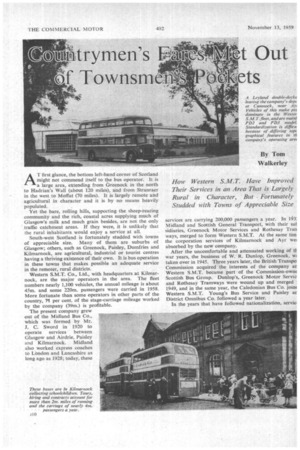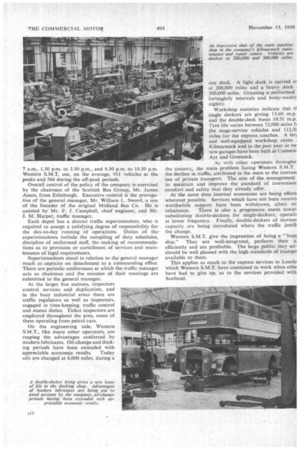How Western S.M.T. Have Improved Their Services in an Area
Page 132

Page 133

Page 134

If you've noticed an error in this article please click here to report it so we can fix it.
That is Largely Rural in Character, But . Fortunately Studded with Towns of Appreciable Size
AT first glance, the bottom left-hand corner of Scotland might not commend itself to the bus operator. It is a large area, extending from Greenock in the north to Hadrian's Wall (about 120 miles), and from Stranraer in the west to Moffat (70 miles). It is largely remote and agricultural in character and it is by no means heavily populated. .
Yet the bare, rolling hills, supporting the sheep-rearing community and the rich, coastal acres supplying much of Glasgow's milk and much grain besides, are not the only ' traffic catchment areas. If they were, it is unlikely that the rural inhabitants would enjoy a service at all.
South-west Scotland is fortunately studded with towns of appreciable size. Many of them are suburbs of Glasgow; others, such as Greenock, Paisley, Dumfries and Kilmarnock, are agricultural, industrial or tourist centres having a thriving existence of their own. It is bus operation in these towns that makes possible an adequate service in the remoter, rural districts.
Western S.M.T. Co., Ltd., with headquarters at Kilmarnock, are the major operators in the area. The fleet numbers nearly 1,100 vehicles, the annual mileage is about 45m, and some 220m. passengers were carried in 1958.
More fortunate than some operators in other parts of the country, 74 per cent, of the stage-carriage mileage worked by the company (39m.) is profitable. The present company grew out of the Midland Bus Co., which was formed by Mr.
J. C. Sword in 1920 to operate services between Glasgow and Airdrie, Paisley and Kilmarnock. Midland also worked express coaches to London and Lancashire as long ago as 1928; today, these services are carrying 200,000 passengers a year. In 1§3: Midland and Scottish General Transport, with their sul sidiaries, Greenock Motor Services and Rothesay Tran ways, merged to form Western S.M.T. At the same tim the corporation services of Kilmarnock and Ayr wei absorbed by the new company, After the uncomfortable and attenuated working of tk war years, the business of W. R. Dunlop, Greenock, w taken over in 1945. Three years later, the British Transpo Commission acquired the interests of the company as Western S.M.T. became part of the Commission-own( Scottish Bus Group. Dunlop's, Greenock Motor Servic. and Rothesay Tramways were wound up and merged . 1949, and in the same year, the Caledonian Bus Co. join( Western S.M.T. Young's Bus Service and Paisley at District Omnibus Co. followed a year later.
In the years that have followed nationalization, servic, ad fleets have been painstakingly tailored to the varying :quirements of the area. Western S.M.T. provide town xvices for five localities: These are (1) Greenock, iourock and Port Glasgow; (2) Paisley, Renfrew and John one; (3) Kilmarnock; (4) Dumfries and (5) Ayr and Prestick. Each of these centres can be regarded as the hub of a individual operation. They are worked from depots . Greenock, Paisley, Johnstone, Kilmarnock, Dumfries id Ayr.
In addition, all the large centres of population are linked / frequent services. In the summer ion ths the coastal road from reenock southwards to Stranraer sumes great importance. It is dotted ith popular holiday resorts and the affic is heavy. Inland, the Glasgowilmarnock-Dumfries road is a busy le, and so is its extension through man to Carlisle. Few of the crossluntry services, linking outlying Rages with the market towns, can be garded as sound commercial propoions, but they are essential and, as ch, every effort is made to retain em.
Over so large an area, with so many feting topographical features, it is possible to standardize a fleet. )me of the town routes are very lly (as in Gourock, Greenock and )rt Glasgow); there are numerous rvices catering for mining districts td there is a large bus-hire business. Thaps the only feature common to the Western S.M.T. area of operations is the low, bridge, which occurs only too often on urban and rural roads.
The greater part of the fleet consists of double-deckers, of which 124 are high-bridge and 681 are low-bridge types. Seating capacities range from 53 to 67. There are 327 Leyland (mostly P.D.2 and P.D.3), 154 Guy Arab, 118 Bristol and a number of A.E.C., Daimler and Albion.
Of the single-deckers, numbering 290, 115 are service buses, seating between 33 and 44 passengers, and 110 are dual-purpose vehicles of the same capacity. There are also 65 luxury coaches, all bodied by Alexander, of Falkirk, with seating for 30 and 41. Singledecker chassis manufacturers include Guy (96). Leyland (93), A.E.C. (24), Bristol (60).
Maudslay (12) and 'Albion (5).
Western S.M.T. operate 131 stage-carriage and five express routes from their 23 depots. In addition, day and extended tours, hire work and contracts account for more than 2m. miles a year, and carry nearly 4m. passengers.
In general, peaks occur four times a day at the customary business hours and, perhaps surprisingly, between 9.30 p.m.
and 10.30 p.m. Shift working in the mining areas creates peak hours peculiar to the industry: they are 5.30 a.m. to 7 a.m., 1.30 p.m. to 3.30 p.m., and 9.30 p.m. to 10.30 p.m.
Western S.M.T. use, on the average, 911 vehicles at the peaks and 566 during the off-peak periods.
Overall control of the policy of the company is exercised by the chairman of the Scottish Bus Group, Mr. James Amos, from Edinburgh. Executive control is the preroga tive of the general manager, Mr. William L. Sword, a son of the founder of the original Midland Bus Co. He is
assisted by Mr. F. J. Campbell, chief engineer, and Mr. J. M. Harper, traffic manager.
Each depot has a district traffic superintendent, who is required to accept a satisfying degree of responsibility for the day-to-day running of operations. Duties of the.
superintendents include the compiling of duty schedules, discipline of uniformed staff, the making of recommenda tions as to provision or curtailment of services and maintenance of legal requirements.
Superintendents stand in relation to the general manager much as captains on detachment to a commanding office.
There are periodic conferences at which the traffic manager acts as chairman and the minutes of their meetings are submitted to the general manager.
At the larger bus stations, inspectors control services and duplication, and in the busy industrial areas there are traffic regulators as well as inspectors, engaged in time-keeping, traffic control and stance duties. Ticket inspectors are employed throughout the area, some of them operating from patrol cars.
On the engineering side, Western S.M.T., like many other operators, are reaping the advantages conferred by modern lubricants. Oil-change and dock ing periods have been extended with appreciable economic results. Today oils are changed at 6,000 miles, during a day dock. A light dock is carried 01 at 200,000 miles and a heavy dock 300,000 miles. Greasing is performed fortnightly intervals and body-washit nightly.
Workshop statistics indicate that tl single deckers are giving 13.69 m.p. and the double-deck buses 10.51 m.p. Tyre life varies between 72,000 miles fl the stage-service vehicles and 112,5( miles for the express coaches. A larl and well-equipped workshop exists Kilmarnock and in the past year or tw new garages have been built at Cumnoc Ayr and Greenock.
As with other operators througho the country, the main problem facing Western S.M.T. the decline in traffic, attributed in the main to the increas( use of private transport. The aim of the management to maintain and improve the standard of convenient comfort and safety that they already offer.
At the same time internal economies are being effect( wherever possible. Services which have not been receivii worthwhile support have been withdrawn, albeit wi reluctance. There is also a progressive move towar substituting double-deckers for single-deckers, operatit at lower frequency. Finally, double-deckers of increas1 capacity are being introduced where the traffic justifi the change.
Western S.M.T. give the impression of being a "hap] ship." They are well-integrated, perform their jc efficiently and are profitable. The large public they ser should be well pleased with the high standards of transpc available to them.
This applies as much to the express services to Londo which Western S.M.T. have continued to work when othe have had to give up, as to the services provided with Scotland.
































































































































































































































































